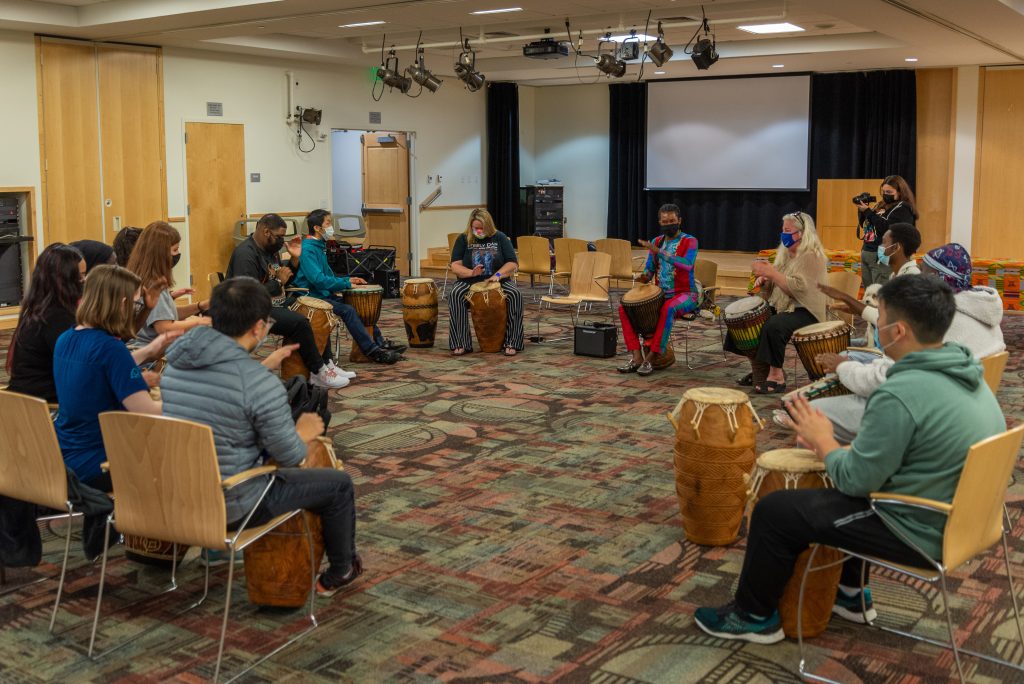The Common Read, beginning with the reading of Laila Lalami’s “Conditional Citizens: On Belonging in America,” aims to promote unity through education and understanding. This mission aligns with that of the Wassa Pan Afrika Dance Ensemble: bringing people together through the power of music regardless of prior knowledge and ability. With a decades-long career in choreography, drumming and ensemble management, Anim’s array of skills and enthralling presence transformed the Multipurpose Room into an creative space full of rhythm and joy. The New York-based Ghanaian founder is a living embodiment of unity as a polyglot, an international performer and a choreographer, speaking seven languages out of the dozens spoken throughout Ghana’s regions.
Anim played many roles over the course of the evening, the first being educator. Before any drums were played, Anim emphasized the importance of connection between player and instrument. He said seven to 11 seconds of focusing time are needed to eliminate distraction and form a creative and spiritual bond. Two types of drums were used: the kpanlogo drums of the people of Accra, Ghana and the traditional West African djembe, differentiated by their tone and exterior paracord designs. Surfaces made of stretched sheep, antelope and cow skins allow the instruments to produce different pitches and tones. As the drums are made from skins, leather and wood, they are a direct connection to nature and are to be treated with the utmost respect. Participants were taught the proper way to sit with the drums to maximize tonality and avoid potential damage before a series of rhythms and striking forms were introduced.
“This is all about receiving the rhythm in your heart,” Anim said.
Anim transitioned from educator to leader, introducing a series of call-and-response drum sequences and establishing a call that would signal a shift in rhythm. Initially, the newness of the instrument left many participants overthinking and confused, regularly straying off beat. However, Anim repeatedly encouraged the circle to play with their hearts rather than their heads and to view it as an act of creativity rather than a source of stress. After the adjustment period, the drum circle achieved perfect harmony as the sequences were repeated, each round growing more integrated with the performers.
By the end of the hour, Anim had segued from leader to motivator, with each member of the drum circle getting a solo to display what they had learned throughout the night. With a chorus of claps from the remainder of the circle, Anim encouraged each member of the circle to play with spirit during their solo time. Any person not actively soloing clapped along to a steady beat, forming a chorus of motivation and a base tempo. Even with an entirely masked group, smiles were noticeable and abundant in the room by the time 7:15 pm. struck.
To conclude the evening, Anim played the role of choreographer and led the students in an hourlong dance class to the traditional African song “Soli.” Through high-energy repetitions of the routine, participants achieved a greater understanding of African music, as well as an excellent cardio workout.
To Atika Kaisary, a freshman majoring in biology, the night’s events were highly influential.
“I’m in the African music class, [Music 112: Music Cultures: Africa, Caribbean and the Americas],” Kaisary said. “I don’t have any prior experience with African music and culture. After I took the class, it made me very interested in knowing about African culture. When I saw this program, I was so excited and needed to learn more about it. I’m so excited right now that I am thinking about declaring Africana studies as a minor.”
Through the workshop, Anim fostered an environment of inclusion and happiness, not only continuing the goals established by the university-wide Common Read but providing an excellent diversion from university stress within the doors C4.



